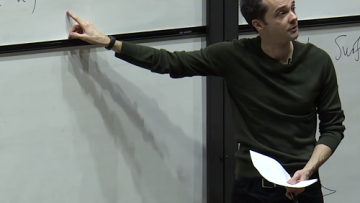One of our aims in Oxford Mathematics is to show what it is like to be an Oxford Mathematics student. With that in mind we have started to make student course materials available and last Autumn we filmed and made available a first year lecture on Complex Numbers. And last week, as we promised, we went a step further and livestreamed a first year lecture. James Sparks was our lecturer and Dynamics his subject.
A generic construction for high order approximation schemes of semigroups using random grids
Abstract
Our aim is to construct high order approximation schemes for general
semigroups of linear operators $P_{t},t \ge 0$. In order to do it, we fix a time
horizon $T$ and the discretization steps $h_{l}=\frac{T}{n^{l}},l\in N$ and we suppose
that we have at hand some short time approximation operators $Q_{l}$ such
that $P_{h_{l}}=Q_{l}+O(h_{l}^{1+\alpha })$ for some $\alpha >0$. Then, we
consider random time grids $\Pi (\omega )=\{t_0(\omega )=0<t_{1}(\omega
)<...<t_{m}(\omega )=T\}$ such that for all $1\le k\le m$, $t_{k}(\omega
)-t_{k-1}(\omega )=h_{l_{k}}$ for some $l_{k}\in N$, and we associate the approximation discrete
semigroup $P_{T}^{\Pi (\omega )}=Q_{l_{n}}...Q_{l_{1}}.$ Our main result is the
following: for any approximation order $\nu $, we can construct random grids $\Pi_{i}(\omega )$ and coefficients
$c_{i}$, with $i=1,...,r$ such that $P_{t}f=\sum_{i=1}^{r}c_{i} E(P_{t}^{\Pi _{i}(\omega )}f(x))+O(n^{-\nu})$
with the expectation concerning the random grids $\Pi _{i}(\omega ).$
Besides, $Card(\Pi _{i}(\omega ))=O(n)$ and the complexity of the algorithm is of order $n$, for any order
of approximation $\nu$. The standard example concerns diffusion
processes, using the Euler approximation for $Q_l$.
In this particular case and under suitable conditions, we are able to gather the terms in order to produce an estimator of $P_tf$ with
finite variance.
However, an important feature of our approach is its universality in the sense that
it works for every general semigroup $P_{t}$ and approximations. Besides, approximation schemes sharing the same $\alpha$ lead to
the same random grids $\Pi_{i}$ and coefficients $c_{i}$. Numerical illustrations are given for ordinary differential equations, piecewise
deterministic Markov processes and diffusions.
Frontiers in Quantitative Finance
On June 13 we will have the Frontiers in Quantitative Finance seminar in London
https://www.maths.ox.ac.uk/groups/mathematical-finance/frontiers-quanti…
Adapted Wasserstein distances and their role in mathematical finance
Abstract
The problem of model uncertainty in financial mathematics has received considerable attention in the last years. In this talk I will follow a non-parametric point of view, and argue that an insightful approach to model uncertainty should not be based on the familiar Wasserstein distances. I will then provide evidence supporting the better suitability of the recent notion of adapted Wasserstein distances (also known as Nested Distances in the literature). Unlike their more familiar counterparts, these transport metrics take the role of information/filtrations explicitly into account. Based on joint work with M. Beiglböck, D. Bartl and M. Eder.
Deep Learning Volatility
Abstract
We present a consistent neural network based calibration method for a number of volatility models-including the rough volatility family-that performs the calibration task within a few milliseconds for the full implied volatility surface.
The aim of neural networks in this work is an off-line approximation of complex pricing functions, which are difficult to represent or time-consuming to evaluate by other means. We highlight how this perspective opens new horizons for quantitative modelling: The calibration bottleneck posed by a slow pricing of derivative contracts is lifted. This brings several model families (such as rough volatility models) within the scope of applicability in industry practice. As customary for machine learning, the form in which information from available data is extracted and stored is crucial for network performance. With this in mind we discuss how our approach addresses the usual challenges of machine learning solutions in a financial context (availability of training data, interpretability of results for regulators, control over generalisation errors). We present specific architectures for price approximation and calibration and optimize these with respect different objectives regarding accuracy, speed and robustness. We also find that including the intermediate step of learning pricing functions of (classical or rough) models before calibration significantly improves network performance compared to direct calibration to data.
Equilibrium asset pricing with transaction costs
Abstract
In the first part of the talk, we study risk-sharing equilibria where heterogenous agents trade subject to quadratic transaction costs. The corresponding equilibrium asset prices and trading strategies are characterised by a system of nonlinear, fully-coupled forward-backward stochastic differential equations. We show that a unique solution generally exists provided that the agents’ preferences are sufficiently similar. In a benchmark specification, the illiquidity discounts and liquidity premia observed empirically correspond to a positive relationship between transaction costs and volatility.
In the second part of the talk, we discuss how the model can be calibrated to time series of prices and the corresponding trading volume, and explain how extensions of the model with general transaction costs, for example, can be solved numerically using the deep learning approach of Han, Jentzen, and E (2018).
(Based on joint works with Martin Herdegen and Dylan Possamai, as well as with Lukas Gonon and Xiaofei Shi)
11:00
A curve in the Möbius band
Abstract
Suppose that you have a long strip of paper, and draw the central line through it. You then glue it together so as to make a Möbius band. Can the drawn curve be contained in a plane?
We'll answer the question in this talk, as well as introduce the concepts from the Geometry of Surfaces course required to go through it; including Gauss' one and only Theorema Egregium! (we won't prove it though).


